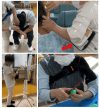Rehabilitation Treatment of a Patient With Total Humeral Endoprosthetic Replacement
- PMID: 38903370
- PMCID: PMC11187010
- DOI: 10.7759/cureus.60716
Rehabilitation Treatment of a Patient With Total Humeral Endoprosthetic Replacement
Abstract
Total humeral endoprosthetic replacement (THR) is a rare surgery for malignant humeral bone tumors. Studies focusing on its surgical methods and functional status are limited. Furthermore, rehabilitation treatment after THR has not been reported. Therefore, this case report aimed to investigate its postoperative rehabilitation treatment and reinstatement. A 69-year-old woman was diagnosed with chondrosarcoma of her left humerus. THR was performed the day following patient admission. The wide resection caused the loss of her left shoulder motor function. She had a left ulnar nerve disorder and carpal tunnel syndrome. Rehabilitation treatments such as joint range of motion training were initiated on postoperative day (POD) 1. We designed a shoulder abductor brace to maintain her left shoulder in an abducted and flexed position so she could use her left hand effectively. The manual muscle testing scores for elbow joint movements gradually improved. On POD47, she was transferred to a convalescent rehabilitation hospital to receive training in activities of daily living and barber work. The patient was discharged on POD107. The Disabilities of the Arm, Shoulder, and Hand score improved from 86.2 (POD7) to 17.2 (POD107). She continued outpatient rehabilitation and reinstated work on POD143. The use of a brace and seamless rehabilitation from the acute phase to convalescence and community-based rehabilitation enabled the patient with THR to return to work. This study suggests that precise assessment of the disorders and consecutive rehabilitation treatment with a brace should be considered after THR.
Keywords: abduction brace; articular range of motion; chondrosarcoma; rehabilitation treatment; return to work; total humeral endoprosthetic replacement.
Copyright © 2024, Choda et al.
Conflict of interest statement
The authors have declared that no competing interests exist.
Figures





References
-
- Limb-sparing surgery preserves more function than amputation: a Scandinavian sarcoma group study of 118 patients. Aksnes LH, Bauer HC, Jebsen NL, Follerås G, Allert C, Haugen GS, Hall KS. J Bone Joint Surg Br. 2008;90:786–794. - PubMed
-
- Comparison of quality of life after amputation or limb salvage. Refaat Y, Gunnoe J, Hornicek FJ, Mankin HJ. Clin Orthop Relat Res. 2002:298–305. - PubMed
-
- The cost-effectiveness of limb salvage for bone tumours. Grimer RJ, Carter SR, Pynsent PB. J Bone Joint Surg Br. 1997;79:558–561. - PubMed
Publication types
LinkOut - more resources
Full Text Sources
